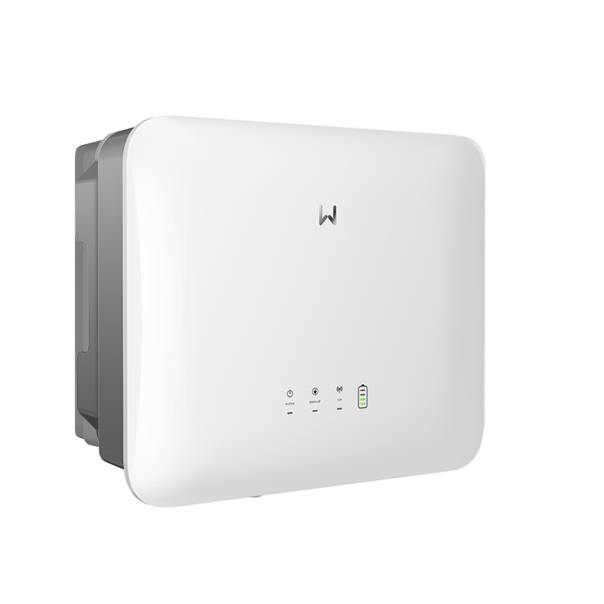GoodWe GW6000-ET-20 AFCI
| Manufacturer |  |
Product prices only visible after login. If you do not have an account, please register.
Technical specifications
GoodWe GW6000-ET-20 – 6 kW Three-Phase Hybrid Inverter with Emergency Power Supply (UPS)
The GoodWe GW6000-ET-20 is a state-of-the-art second-generation hybrid inverter (ET G2), designed for efficient and reliable photovoltaic installations in single-family homes and small businesses. It not only enables effective energy conversion from PV modules but also allows energy storage and smart consumption management – in both on-grid and off-grid modes.
Thanks to its integrated Uninterruptible Power Supply (UPS) function, the inverter ensures uninterrupted operation of household appliances even during a grid outage.
The device also supports SG Ready solutions, meaning it is prepared to work with EV chargers and other smart home appliances. High efficiency, robust construction, a wide voltage range, and intuitive operation make it an ideal solution for users seeking maximum energy independence.
Downloads
- Other
- Certificate IEC 63027 GW(6-15)K-ET-20 EN.pdf
File size: 1 MB
- Certificate IEC62109 EN62109 CE LVD GW(6-15)K-ET-20 EN.pdf
File size: 2 MB
- Certyfikat NC-RfG GW(6-15)K-ET-20 PL_1.pdf
File size: 13 MB
- Communications Module Compatibility Sheet GW(6-15)K-ET-20 EN.pdf
File size: 1 MB
- Datasheet GW(6-15)K-ET-20 EN.pdf
File size: 385 KB
- Description of the communication port GW(6-15)K-ET-20 EN.pdf
File size: 6 MB
- Inverter compatible energy storage units GW(6-15)K-ET-20 EN.pdf
File size: 338 KB
- Shortened installation manual GW(6-15)K-ET-20 EN.pdf
File size: 14 MB
-
Variants
Product description
GoodWe GW6000-ET-20 – 6 kW Three-Phase Hybrid Inverter with Emergency Power Supply (UPS)
The GoodWe GW6000-ET-20 is a state-of-the-art second-generation hybrid inverter (ET G2), designed for efficient and reliable photovoltaic installations in single-family homes and small businesses. It not only enables effective energy conversion from PV modules but also allows energy storage and smart consumption management – in both on-grid and off-grid modes.
Thanks to its integrated Uninterruptible Power Supply (UPS) function, the inverter ensures uninterrupted operation of household appliances even during a grid outage.
The device also supports SG Ready solutions, meaning it is prepared to work with EV chargers and other smart home appliances. High efficiency, robust construction, a wide voltage range, and intuitive operation make it an ideal solution for users seeking maximum energy independence.
Key Features and Functionality:
Emergency power supply with UPS function – immediate switchover to off-grid mode
Supports high-voltage lithium-ion batteries (150–720 V)
Smart operating modes and energy self-consumption
Built-in energy meter (Smart Meter) – no additional components required
Remote control and monitoring – via WiFi, LAN, Bluetooth, and mobile app
Communication with BMS systems – RS485 / CAN
Supports SG Ready EV chargers and home appliances
High build quality – passive cooling and IP66 protection rating
Technical Data (Key Parameters):
Inverter type: Hybrid, three-phase
AC output power: 6,000 W
Number of MPPTs: 2
Max. efficiency: 98.0%
European efficiency: 97.2%
Battery voltage range: 150 – 720 V
Max. charge/discharge power: 9,000 W / 6,600 W
Max. PV input power: 9,600 W
MPPT voltage range: 120 – 850 V
Nominal input voltage: 620 V
Nominal AC output voltage: 400 / 380 V
Max. AC output current: 8.7 A
Max. backup power (UPS): 6,000 VA (up to 12,000 VA for 60 seconds)
Communication: RS485, CAN, WiFi, LAN, Bluetooth
Nighttime power consumption: <15 W
Protection rating: IP66
Dimensions: 496 × 460 × 221 mm
Weight: 23 kg
Noise level: <30 dB
Topology: Non-isolated
Thanks to the use of the latest technologies and full compatibility with energy storage systems and smart home solutions, the GoodWe GW6000-ET-20 is more than just an inverter – it's a comprehensive energy management hub. It is perfectly suited for modern photovoltaic installations where reliability, cost-efficiency, and maximum independence from the power grid are essential.





